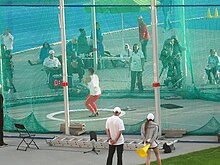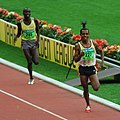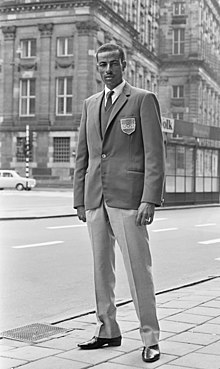Introduction

Athletics is a group of sporting events that involves competitive running, jumping, throwing, and walking. The most common types of athletics competitions are track and field, road running, cross-country running, and racewalking.
The results of racing events are decided by finishing position (or time, where measured), while the jumps and throws are won by the athlete that achieves the highest or furthest measurement from a series of attempts. The simplicity of the competitions, and the lack of a need for expensive equipment, makes athletics one of the most common types of sports in the world. Athletics is mostly an individual sport, with the exception of relay races and competitions which combine athletes' performances for a team score, such as cross country.
Organized athletics are traced back to the Ancient Olympic Games from 776 BC. The rules and format of the modern events in athletics were defined in Western Europe and North America in the 19th and early 20th century, and were then spread to other parts of the world. Most modern top level meetings are held under the auspices of World Athletics, the global governing body for the sport of athletics, or its member continental and national federations. (Full article...)
General images -
Selected article

The hammer throw is one of the four throwing events in regular outdoor track and field competitions, along with the discus throw, shot put and javelin.
The "hammer" used in this sport is not like any of the tools also called by that name. It consists of a metal ball attached by a steel wire to a grip. These three components are each separate and can move independently. Both the size and weight of the ball vary between men's and women's events. The women's hammer weighs 4 kilograms (8.8 lb) for college and professional meets while the men's hammer weighs 7.26 kilograms (16.0 lb). (Full article...)
The men's hammer weighs 16 pounds (7.26 kg) and measures 3 feet 11+3⁄4 inches (121.3 cm) in length, and the women's hammer weighs 4 kg (8.82 lb) and 3 ft 11 in (119.4 cm) in length.[1] Like the other throwing events, the competition is decided by who can throw the implement the farthest.
The throwing motion starts with the thrower swinging the hammer back-and-forth about two times to generate momentum. The thrower then makes three, four or (rarely) five full rotations using a complex heel-toe foot movement, spinning the hammer in a circular path and increasing its angular velocity with each rotation. Rather than spinning the hammer horizontally, it is instead spun in a plane that angles up towards the direction in which it will be launched. The thrower releases the hammer as its velocity is upward and toward the target.[2]

Throws are made from a throwing circle. The thrower is not allowed to step outside the throwing circle before the hammer has landed and may only enter and exit from the rear of the throwing circle. The hammer must land within a 34.92º throwing sector that is centered on the throwing circle. The sector angle was chosen because it provides a sector whose bounds are easy to measure and lay out on a field (10 metres out from the center of the ring, 6 metres across).[3][4] A violation of the rules results in a foul and the throw not being counted.[citation needed]
| More selected articles |
Selected picture

Athlete birthdays
22 March:
- Armin Hary, German sprinter
- Hwang Young-cho, Korean distance runner
- Staņislavs Olijars, Latvian hurdler
- António Pinto, Portuguese distance runner
- Michel Théato, Luxembourgish-French distance runner
- Zhang Wenxiu, Chinese hammer thrower
23 March:
- Platt Adams, American standing jumper
- Roger Bannister, British middle-distance runner
- Jerry Cornes, British middle-distance runner
- Mo Farah, British distance runner
- Frank Irons, American long jumper
- Ana Fidelia Quirot, Cuban middle-distance runner
24 March:
- Floyd Heard, American sprinter
- Albert Hill, British middle-distance runner
- Periklís Iakovákis, Greek hurdler
- Lucy Wangui Kabuu, Kenyan distance runner
- Emmit King, American sprinter
- Sergey Klyugin, Russian high jumper
- Renaldo Nehemiah, American hurdler
- William Porter, American hurdler
- Torsten Voss, German decathlete
25 March:
- Irving Baxter, American jumper
- Christina Cahill, British middle-distance runner
- María Caridad Colón, Cuban javelin thrower
- Stacy Dragila, American pole vaulter
- Muriel Hurtis-Houairi, French sprinter
- Abdalaati Iguider, Moroccan middle-distance runner
- Carl Kaufmann, German sprinter
- Stefka Kostadinova, Bulgarian high jumper
- Gunnar Nielsen, Danish middle-distance runner
- Aleksandr Puchkov, Soviet hurdler
- Irina Stankina, Russian race walker
- Mitchell Watt, Australian long jumper
26 March:
- Lennart Atterwall, Swedish javelin thrower
- Barbara Jones, American sprinter
- Stig Pettersson, Swedish high jumper
- Tatyana Providokhina, Soviet middle-distance runner
- Violeta Szekely, Romanian middle-distance runner
- Vilho Tuulos, Finnish triple jumper
27 March:
- Nunu Abashidze, Soviet shot putter
- Irina Belova, Russian heptathlete
- Yuliya Golubchikova, Russian pole vaulter
- Jukka Keskisalo, Finnish steeplechase runner
- Aleksandr Klimenko, Ukrainian shot putter
- Antonina Lazareva, Soviet high jumper
- Mihaela Melinte, Romanian hammer thrower
- Dean Starkey, American pole vaulter
28 March:
- Ladji Doucouré, French hurdler
- Harvey Glance, American sprinter
- Evelin Jahl, German discus thrower
- Sylvia Kibet, Kenyan distance runner
- Aksana Miankova, Belarusian hammer thrower
- Martin Sheridan, Irish-American thrower and standing jumper
- Józef Szmidt, Polish triple jumper
- Ilke Wyludda, German discus thrower
- Olga Yegorova, Russian middle- and long-distance runner
Related portals
More did you know
- ... that Ethiopian long-distance runner Atsede Habtamu set a new course record at the Eindhoven Marathon with her first marathon victory earlier this month?
- ... that 2006 National Capital Marathon winner Amos Tirop Matui was disqualified and received financial compensation due to a misplaced barrier on the course?
- ... that Australian runner Michael Shelley lost his scholarship funding and suffered a broken leg in 2009, but went on to win a silver medal in the marathon at the 2010 Commonwealth Games?
- ... that Irene Kosgei, despite injuring her knee at a drinks station early in the women's marathon at the 2010 Commonwealth Games, edged compatriot Irene Mogaka to become the first Kenyan woman to win a Commonwealth marathon title?
| Archive |
Selected biography
Shambel Abebe Bikila (Amharic: ሻምበል አበበ ቢቂላ; August 7, 1932 – October 25, 1973) was an Ethiopian marathon runner who was a back-to-back Olympic marathon champion. He was the first Ethiopian Olympic gold medalist, winning his and Africa's first gold medal at the 1960 Summer Olympics in Rome while running barefoot. At the 1964 Tokyo Olympics, he won his second gold medal. In turn, he became the first athlete to successfully defend an Olympic marathon title. In both victories, he ran in world record time.
Born in Shewa, Abebe moved to Addis Ababa around 1952 and joined the 5th Infantry Regiment of the Ethiopian Imperial Guard, an elite infantry division that safeguarded the emperor of Ethiopia. Abebe served in the Kagnew Battalion during Korean War.
Enlisting as a soldier before his athletic career, he rose to the rank of shambel (captain). Abebe participated in a total of sixteen marathons. He placed second on his first marathon in Addis Ababa, won twelve other races, and finished fifth in the 1963 Boston Marathon. In July 1967, he sustained the first of several sports-related leg injuries that prevented him from finishing his last two marathons. Abebe was a pioneer in long-distance running. Mamo Wolde, Juma Ikangaa, Tegla Loroupe, Paul Tergat, and Haile Gebrselassie—all recipients of the New York Road Runners' Abebe Bikila Award—are a few of the athletes who have followed in his footsteps to establish East Africa as a force in long-distance running.
On March 22, 1969, Abebe was paralysed due to a car accident. He regained some upper-body mobility, but he never walked again. While he was receiving medical treatment in England, Abebe competed in archery and table tennis at the 1970 Stoke Mandeville Games in London. Those games were an early predecessor of the Paralympic Games. He competed in both sports at a 1971 competition for disabled people in Norway and won its cross-country sleigh-riding event. Abebe died at age 41 in 1973 of a cerebral haemorrhage related to his accident four years earlier. He received a state funeral, and Emperor Haile Selassie declared a national day of mourning. Many schools, venues, and events, including Abebe Bikila Stadium in Addis Ababa, are named after him. He is the subject of biographies and films documenting his athletic career, and he is often featured in publications about the marathon and the Olympics. (Full article...)
| More selected biographies |
Did you know (auto-generated) -

- ... that German runner Alica Schmidt, who is running in the Women's 4 × 400 metres relay at the 2020 Summer Olympics, has won multiple European junior relay medals?
- ... that Marthe Yankurije, who dropped out of school during her fourth year of secondary school, competed at the 2020 Summer Olympics?
- ... that in the 1932 baseball game in which pitcher Eddie Rommel won his last game, he pitched 17 innings in relief, an American League record?
- ... that every competitor at the 2021 British Athletics Marathon and 20km Walk Trial received a commemorative bonsai tree?
- ... that the women's race at today's New York City Marathon will feature two of the medalists from this year's Olympic marathon?
- ... that at the 2022 British Athletics Championships, Daryll Neita became the first woman since 2010 to win both the 100- and 200-metre events?
- ... that at the 2022 British Indoor Athletics Championships, Lorraine Ugen equalled the championship long jump record?
- ... that for the first time this century, this year's British Athletics Championships were not broadcast on live television?
World records
| Event | Men | Record | Women | Record |
|---|---|---|---|---|
| 100 m | 9.58 | 10.49 | ||
| 200 m | 19.19 | 21.34 | ||
| 400 m | 43.03 | 47.60 | ||
| 800 m | 1:40.91 | 1:53.28 | ||
| 1500 m | 3:26.00 | 3:50.07 | ||
| 3000 m | 7:20.67 | 8:06.11 | ||
| 5000 m | 12:35.36 | 14:06.62 | ||
| 10,000 m | 26:11.00 | 29:01.03 | ||
| Half marathon | 57:31 | 1:02:52 | ||
| Marathon | 2:01:39 | 2:14:04 | ||
| 3000 m steeplechase | 7:53.63 | 8:44.32 | ||
| 110 / 100 m hurdles | 12.80 | 12.12 | ||
| 400 m hurdles | 45.94 | 50.68 | ||
| High jump | 2.45 m | 2.09 m | ||
| Pole vault | 6.21 m | 5.06 m | ||
| Long jump | 8.95 m | 7.52 m | ||
| Triple jump | 18.29 m | 15.74 m | ||
| Shot put | 23.37 m | 22.63 m | ||
| Discus throw | 74.08 m | 76.80 m | ||
| Hammer throw | 86.74 m | 82.98 m | ||
| Javelin throw | 98.48 m | 72.28 m | ||
| Decathlon/Heptathlon | 9126 pts. | 7291 pts. | ||
| 20 km racewalk | 1:17:16 | 1:24:38 | ||
| 50 km racewalk | 3:32:33 | Lindsay Pelas | — | |
| 4×100 m relay | 36.84 | 40.82 | ||
| 4×400 m relay | 2:54.29 | 3:15.17 |
Topics
Athletics events
|
|
|
|
|
Athletics competitions
It's from the first edition (1896 Summer Olympics), that Athletics has been considered the "Queen" of the Olympics. Since then there have been a series of competitions organized at world level, than at the continental level. Furthermore, the Athletics is the main sport of nearly all multi-sport events such as Universiade, Mediterranean Games or Pan American Games. The following list refers to the main Athletics competitions that take place in the world.
| Event | 1st edition | Kind of competition | Can participate |
|---|---|---|---|
| Olympic Games | 1896 | World games | |
| World Championships | 1983 | World championships | |
| World Indoor Championships | 1985 | ||
| European Championships | 1934 | Continental championships | |
| European Indoor Championships | 1966 | ||
| South American Championships | 1919 | ||
| Asian Championships | 1973 | ||
| African Championships | 1979 | ||
| Ocenian Championships | 1990 |
Federations
- Internationals
 International Association of Athletics Federations (IAAF)
International Association of Athletics Federations (IAAF) European Athletics Association (EAA)
European Athletics Association (EAA) Confederation of African Athletics (CAA)
Confederation of African Athletics (CAA) Asian Athletics Association (AAA)
Asian Athletics Association (AAA) North American, Central American and Caribbean Athletic Association
North American, Central American and Caribbean Athletic Association CONSUDATLE
CONSUDATLE Oceania Athletics Association (OAA)
Oceania Athletics Association (OAA)
- Nationals
 Australia: Athletics Australia (AA)
Australia: Athletics Australia (AA) Brazil: Brazilian Athletics Confederation (CBAt)
Brazil: Brazilian Athletics Confederation (CBAt) Canada: Athletics Canada (AC)
Canada: Athletics Canada (AC) Czech: Czech Athletics Federation (ČAS)
Czech: Czech Athletics Federation (ČAS) France: Fédération française d'athlétisme (FFA)
France: Fédération française d'athlétisme (FFA) Germany: German Athletics Association (DLV)
Germany: German Athletics Association (DLV) Italy: Italian Athletics Federation (FIDAL)
Italy: Italian Athletics Federation (FIDAL) Jamaica: Jamaica Athletics Administrative Association (JAAA)
Jamaica: Jamaica Athletics Administrative Association (JAAA) Japan: Japan Association of Athletics Federations (JAAF)
Japan: Japan Association of Athletics Federations (JAAF) Kenya: Athletics Kenya (AK)
Kenya: Athletics Kenya (AK) China: Chinese Athletic Association
China: Chinese Athletic Association Norway: Norwegian Athletics Association
Norway: Norwegian Athletics Association Romania: Romanian Athletics Federation
Romania: Romanian Athletics Federation Spain: Royal Spanish Athletics Federation (RFEA)
Spain: Royal Spanish Athletics Federation (RFEA) Great Britain: UK Athletics (UKA)
Great Britain: UK Athletics (UKA) United States: USA Track & Field (USATF)
United States: USA Track & Field (USATF)
- Others
 Wales: Welsh Athletics (WA)
Wales: Welsh Athletics (WA) England: Amateur Athletic Association of England (AAA)
England: Amateur Athletic Association of England (AAA) Scotland: Scottishathletics
Scotland: Scottishathletics Athletic Association of Small States of Europe (AASSE)
Athletic Association of Small States of Europe (AASSE)
Categories
Associated Wikimedia
The following Wikimedia Foundation sister projects provide more on this subject:
-
 Commons
Commons
Free media repository -
 Wikibooks
Wikibooks
Free textbooks and manuals -
 Wikidata
Wikidata
Free knowledge base -
 Wikinews
Wikinews
Free-content news -
 Wikiquote
Wikiquote
Collection of quotations -
 Wikisource
Wikisource
Free-content library -
 Wikiversity
Wikiversity
Free learning tools -
 Wiktionary
Wiktionary
Dictionary and thesaurus
Sources
- ^ "Hammer Throw". World Athletics. Archived from the original on November 19, 2021. Retrieved May 12, 2022.
- ^ Johannsen, Dana (1 August 2021). "Tokyo 2020: Why the Olympic hammer throw may become a new national obsession". Stuff. Retrieved 1 August 2021.
- ^ "Hammer Throw". World Athletics.
- ^ "Laying Out Sector Angles for the Track and Field Throwing Events" (PDF). USA Track & Field Pacific Northwest. Archived (PDF) from the original on 2015-05-13. Retrieved 2022-03-19.
The shot, discus, hammer & weight throw sector is 34.92º. This angle was chosen due to its simple geometry.




















































